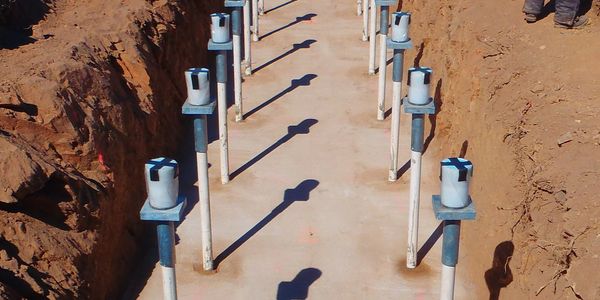Williams Anchors: The Preferred Choice for Crucial Anchoring in Challenging Settings
Williams Anchors: The Preferred Choice for Crucial Anchoring in Challenging Settings
Blog Article
Reliable Rock Anchors for Secure and Steady Structures
In the world of civil engineering, the duty of trusted rock anchors can not be overemphasized, as they are critical in establishing protected and stable foundations throughout a range of applications. Recognizing the various kinds of rock anchors, their particular applications, and the details of installment and upkeep is necessary for maximizing their performance.
Kinds Of Rock Anchors

Easy supports depend on the weight of the framework and the bordering dirt or rock to provide resistance. Active anchors, on the other hand, involve the application of stress with a high-strength cable television or pole, developing a pre-stressed condition in the anchor - Williams Anchors.
Grouted anchors are an additional substantial category, where a steel bar or cable television is inserted right into a drilled hole, adhered to by a cementitious grout. Once treated, the grout bonds with the surrounding rock, creating a durable anchoring system. Each kind of rock support supplies distinct benefits based upon the certain geological conditions and architectural demands, therefore playing a critical function in the general honesty and long life of constructed facilities.
Applications in Building And Construction
Rock supports play a crucial duty in numerous building and construction applications, giving essential support and security in diverse environments. These ingenious remedies are utilized in tasks ranging from large facilities developments to smaller property frameworks. One of the main applications of rock supports is in the stablizing of slopes and keeping wall surfaces, where they help stop dirt disintegration and maintain structural integrity.
Furthermore, rock anchors contribute in safeguarding foundations for bridges, tunnels, and high-rise buildings, guaranteeing they can endure lateral forces such as wind and seismic activity. Their versatility enables installation in tough geological problems, making them suitable for tasks in hilly or rocky surfaces.

Trick Selection Requirements
Selecting the suitable rock support for a particular application calls for mindful consideration of a number of key criteria. First and leading, the geological problems of the website must be completely analyzed. Recognizing rock type, toughness, and stability is necessary to make certain that the anchor will carry out effectively under lots conditions.

Another essential element is the deterioration resistance of the anchor products. In environments revealed to wetness or chemicals, making use of corrosion-resistant materials will certainly extend the lifespan of the supports and maintain structural stability check out here gradually.
In addition, the support's installment approach must align with the task's demands and constraints. Alleviate look at here now of installation, along with the prospective influence on bordering structures, must be taken into consideration.
Installation Methods
Reliable setup strategies are crucial for the successful performance of rock supports. Appropriate installation makes sure that the anchors accomplish the desired load-bearing capacity and stability within the geological conditions. The primary step in the setup procedure entails website assessment, where geological surveys identify the rock kind, problem, and any possible challenges.
Once the site is assessed, the suitable drilling method must be chosen-- choices include rotating boring, diamond drilling, or percussion drilling. The selection relies on rock firmness and environmental considerations. Precise boring deepness and angle are necessary to guarantee that the supports align with architectural needs and lots circulation.
After drilling, the next phase entails cleaning the borehole to eliminate particles, which can compromise bond toughness. Following this, the support is put, and if called for, a cement or resin is infused to boost bond. The treating time of these products have to be abided by, making certain that the anchors achieve full toughness prior to any type of lots is published here used.
Upkeep and Inspection
Proper upkeep and evaluation of rock anchors are essential to ensure their long-lasting efficiency and reliability (Williams Anchors). Routine analyses assist identify any kind of potential concerns, such as rust, displacement, or architectural exhaustion that can jeopardize the stability of the anchoring system
Routine inspections must be performed at specified periods, thinking about ecological factors and the specific application of the rock supports. Visual examinations must concentrate on the exposed sections of the anchors, checking for signs of rust, splits, or other anomalies. Additionally, it is vital to review the surrounding geological problems to spot any kind of changes in soil or rock that might affect anchor performance.
Sometimes, even more advanced techniques such as load testing or non-destructive screening might be necessitated to establish the supports' load-bearing ability and total health. Appropriate paperwork of inspection findings, upkeep activities, and any type of repairs or replacements executed is vital for continuous assessment and compliance with sector requirements.
Verdict
To conclude, dependable rock supports play a vital function in guaranteeing safe and secure foundations throughout numerous construction applications. By effectively transferring loads and enhancing stability versus side pressures, these supports add dramatically to the long life and stability of frameworks such as bridges, tunnels, and maintaining wall surfaces. Strategic choice, setup, and upkeep of rock anchors are crucial for optimizing performance and protecting public security, inevitably underscoring their importance in modern-day design methods.
Report this page